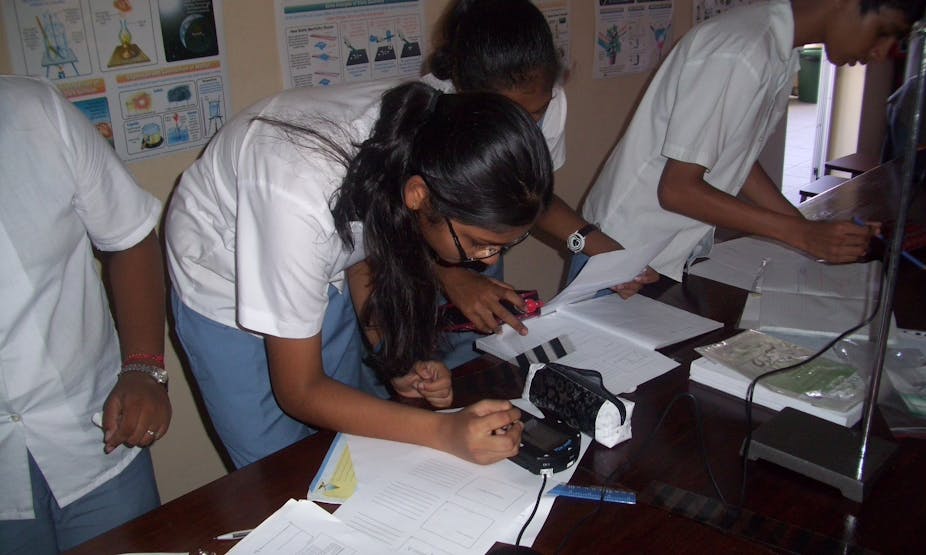Educational psychologist Dr Benjamin Bloom wanted to understand how people learn. So in 1965 he and his colleagues created Bloom’s taxonomy: a system for identifying, understanding and addressing learning. They came up with a system that’s composed of two elements: thinking and the ability to apply knowledge, and then feelings and emotions.
When a student learns about gravity, the cognitive elements would include knowledge and understanding of the concept of a force pulling an object towards the Earth; acceleration, mass and so on. The moment the student has developed understanding, she would be in a position to apply (psychomotor) – the acquired knowledge and skills in new situations. For example, she might want to see what would happen if something different was done to the same object – would it experience the same acceleration?
This learning process doesn’t happen in an isolated context. It takes place during interactions with peers and teachers – what the model refers to as the affective domain. That is the elements of learning that affect emotional development. Elements of interest, motivation and values would help the student to appreciate the discussion and value the ideas as well as encourage her to develop social skills appropriate to working in groups. Eventually, development of this domain benefits broader communities and society as a whole.
Some researchers claim that integrating technology into teaching and learning improves students’ grades. Others argue that technology makes little difference to how students perform because traditional approaches to teaching still predominate.
A lot of research in this area has focused on technology as a tool. But what is the value of technology as a medium to encourage interactions between parents, teachers and students – tapping into the affective domain – and ensure that students construct knowledge?
Myself and other academics from the Mauritius Institute of Education and London’s Brunel University wanted to know how technology could be used to transform the teaching and learning process into an innovative, interactive environment that promotes students’ cognitive development driven by the affective domain. So we embarked on a study that attempted to build a case for incorporating the affective domain in the teaching and learning of physics using technology.
A space to develop the affective domain
The study was carried out in two phases: exploratory and evaluative. The evaluative phase confirmed the findings made in the exploratory phase.
The exploratory phase involved one teacher, 22 students (all 13 and 14 years old) from a coeducational school situated in Mauritius’ central region and 19 parents.
In the evaluative phase 31 students from an all-girls’ school (in the same region as the first school), 15 parents and one physics teacher participated.
We developed a framework called the Pedagogical Technological Integrated Medium. It is founded on a well-documented framework, TPACK, which was created to facilitate the use of technology in schools. Our framework helps learners to create knowledge and develop an understanding of physics through interactions between teachers, students and parents.
We created an interactive website to monitor how parents, teachers and students were engaging with the framework. The site encompasses a series of home tasks (parent–student and parent-teacher interactions), in-class tasks (student-teachers) and out-of-school activities (parent-student-teacher interactions).
For instance, students used the website to consolidate their existing knowledge of measurement as a concept in physics. They did this in collaboration with their parents before attending classes.
The experiment showed that learners benefited enormously from the approach we had adopted. By creating the affective domain through interactions with their parents (at home) and teachers (at school), the students were able to construct physics knowledge. The added dimension was that we used technology as a medium to meet this end.
Benefits of our approach
The framework was well received by students, parents and teachers. One parent told us:
I was happy that my daughter was discussing with me and I encouraged her to complete all the tasks and to tell me if she had any difficulty.
Students said they wanted to do more activities and be provided with more notes on the website because this would help them “to learn better”. One said,
I would like to try it first before learning it [the concept] at school.
The teachers were also happy. One said that, “the activities contained in the web lesson have helped me to understand in which specific areas students hold misconceptions”. The teacher also hailed the chance to “innovate in my teaching”.
Integrating the affective domain into our model has shown the potential of key educational stakeholders – parents, students and teachers – to collaborate. The teacher established a network with parents and learners and used the insights gained to construct her interactive lessons.
The schools we worked with are planning to use the website to sustain the interaction that’s been developed between teachers, students and parents. We also plan to get more schools in Mauritius using this system.
The affective domain matters
Our study has provided evidence of a change in students’ attitudes: they claimed to be interested, motivated and better prepared to learn new concepts in class.
It’s been known for a long time that educational technology can offer opportunities for cognitive development in learning science. We’ve now proved that this isn’t sufficient unless the affective domain forms an integral part of teaching and learning when technology is integrated into the process.

